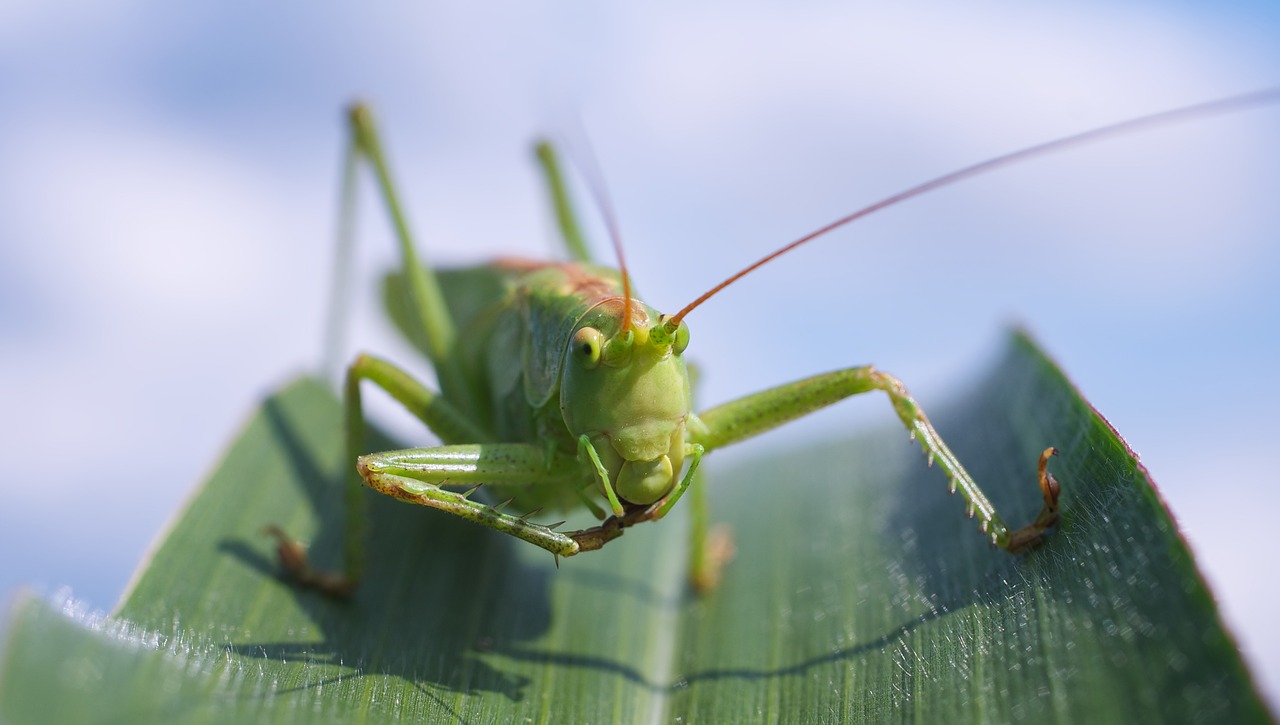- Grasshoppers belong to the order Orthoptera, which also includes crickets and katydids.
- Grasshoppers are found on every continent except Antarctica, thriving in diverse habitats such as grasslands, forests, and deserts.
- There are around 11,000 known species of grasshoppers, each varying in size, color, and behavior.
- Grasshoppers have specialized chewing mouthparts that allow them to consume a wide range of plant material.
- They are capable of producing sounds through a process called stridulation, where they rub their legs or wings together.
- Grasshoppers have a high reproductive potential, with females laying hundreds of eggs in soil or plant material.
- These insects undergo incomplete metamorphosis, meaning they hatch from eggs into nymphs that resemble miniature versions of adults.
- Grasshopper nymphs molt several times as they grow, shedding their exoskeletons and developing wings gradually.
- The lifespan of a grasshopper varies among species, with some living for a few months while others can survive up to a year.
- Grasshoppers are known for their incredible jumping ability, thanks to their powerful hind legs and the energy stored in their cuticles.
- They can jump vertically up to 20 times their body length and horizontally up to 40 times their body length.
- Grasshoppers have large compound eyes that provide a wide field of vision and enable them to detect predators and locate food.
- They also have three small eyes called ocelli, which are sensitive to light intensity and help with orientation.
- Grasshoppers communicate through a combination of visual signals, sounds, and pheromones.
- Some grasshopper species display remarkable coloration and patterns on their bodies, serving as warning signals to potential predators.
- Grasshoppers exhibit a wide range of feeding behaviors, including generalist herbivory, specialization on certain plant species, and even carnivory.
- They play a crucial role in nutrient cycling by consuming plant material and returning organic matter to the soil through their droppings.
- Grasshoppers have been considered a delicacy in some cultures and are consumed as a source of protein.
- Some species of grasshoppers can cause significant agricultural damage by consuming crops in large numbers, leading to economic losses.
- Grasshoppers are equipped with powerful jaws that allow them to chew through tough plant tissues.
- They have an efficient digestive system that enables them to extract nutrients from plant cellulose.
- Grasshoppers have an ability called autotomy, where they can voluntarily detach their legs or wings as a defense mechanism to escape from predators.
- They have complex mating behaviors, with males using visual displays, stridulation, and pheromones to attract females.
- Grasshoppers exhibit different reproductive strategies, including both solitary and gregarious species.
- Some species of grasshoppers engage in “hilltopping,” where males gather at high points to attract females for mating.
- Grasshoppers are preyed upon by a variety of animals, including birds, mammals, reptiles, and other insects.
- They have evolved various adaptations for defense, such as camouflage, toxic compounds, and rapid jumping to evade predators.
- Grasshoppers are highly adaptable insects, capable of adjusting their feeding habits and behaviors to changing environmental conditions.
- They are most active during warm, sunny weather and are often seen basking in the sun to regulate their body temperature.
- Grasshoppers can withstand extreme temperatures and survive in harsh environments by going into a dormant state called diapause.
- Some grasshopper species migrate over long distances in search of suitable breeding and feeding grounds.
- Grasshoppers have a remarkable ability to regenerate lost body parts, including legs and antennae, through the process of molting.
- They are excellent climbers, using specialized spines on their legs to grip onto various surfaces.
- Grasshoppers have a relatively low metabolic rate, allowing them to conserve energy and survive in resource-limited environments.
- Some grasshopper species display aposematic coloration, warning predators of their unpalatability or toxicity.
- They are capable of producing sounds with different frequencies and patterns, which can vary between species.
- Grasshoppers have a unique organ called the tympanal organ that allows them to detect airborne sounds.
- They possess a highly efficient respiratory system that delivers oxygen directly to their tissues through a network of tubes called tracheae.
- Grasshoppers have a segmented body composed of a head, thorax, and abdomen, providing flexibility and mobility.
- They molt their exoskeletons periodically to accommodate growth and repair any damage to their outer covering.
- Grasshoppers have been studied for their potential as bioindicators, as changes in their populations can reflect environmental disturbances.
- They are an important food source for many animals, contributing to energy transfer and food webs in ecosystems.
- Grasshoppers play a role in seed dispersal by consuming plant seeds and later excreting them in different locations.
- They are highly responsive to changes in their environment, exhibiting behaviors such as swarming or dispersing in response to population dynamics or habitat conditions.
- Grasshoppers have been the subject of scientific research in fields such as ecology, physiology, behavior, and genetics.
- They possess a unique ability to regenerate damaged nerve cells, making them an interesting model for neurobiological studies.
- Grasshoppers have been featured in various cultural and artistic representations, symbolizing resilience, freedom, and nature.
- They have been used in some traditional medicines for their supposed therapeutic properties.
- Grasshoppers are sometimes kept as pets or used in educational settings to study insect behavior and biology.
- Grasshoppers have existed on Earth for millions of years, with fossil evidence dating back to the Carboniferous period.
Facebook Comments


































